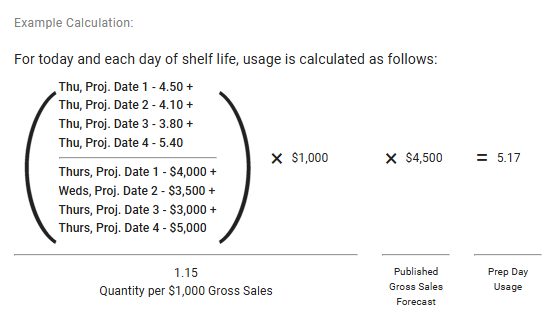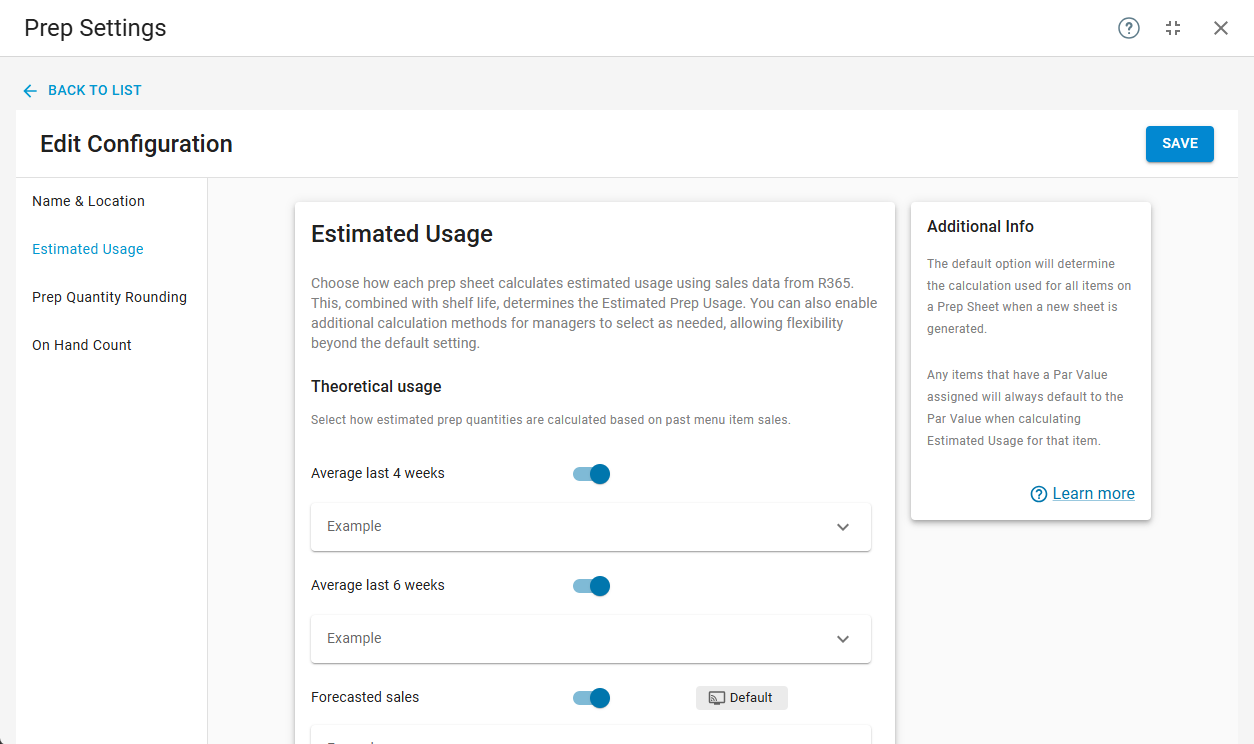This feature is in beta for select customers. Contact your CSM for more information.
In R365, Prep Management uses estimated usage to predict how much of each prep item should be produced for a location on any given day. Estimated usage represents the expected quantity of a prep item needed based on historical or forecasted gross sales.
Each prep item’s estimated usage is calculated from its theoretical usage per 1,000, which defines how much of an item is typically used for every $1,000 in sales. The estimated usage formula multiplies that theoretical usage value by either:
the average gross sales from previous weeks, or
the forecasted gross sales for the day
The result is an expected usage amount for each day in the item’s shelf life window. The estimated usage calculation is as follows:
Estimated Usage = (Theoretical Usage per 1000) × (Gross Sales ÷ 1,000)
The Gross Sales value used in this formula depends on the selected calculation method:
Average of Last 4 Weeks method uses the average gross sales from the same weekday over the past four weeks.
Average of Last 6 Weeks method uses the average gross sales from the same weekday over the past six weeks.
Forecasted Sales method uses the published forecasted gross sales for each day.
For all calculation methods, if a day within the historical period has $0 total gross sales, that day is excluded from the calculation. This prevents inaccurate averages and ensures that estimated usage values reflect only days with valid sales data.
When a Prep Sheet is generated, the system takes the estimated usage and compares it against the prep item’s on hand quantity to calculate the Prep Quantity. The prep quantity is how much should be prepped for the day. Read more about prep sheets.
Average of Last 4 Weeks
The 4-week average method uses historical data from the same day of the week over the past four weeks. It calculates the average quantity of each prep item used per $1,000 in sales for those matching days.
For example, if today is Monday, it will take an average of the gross sales from the last four Mondays.
Formula:Estimated Usage = (Theoretical Usage per 1000) × (Average Gross Sales ÷ 1,000)
Variable | Description |
|---|---|
Theoretical Usage per 1000 | The calculated amount of the item used for every $1,000 in sales. |
Average Gross Sales | The average sales total for the same day of the week over the past four weeks. |
This method provides a short-term view of usage trends. It’s best used when recent weekly patterns most accurately reflect current demand.
Average of Last 6 Weeks
The 6-week average method uses historical data from the same day of the week over the past six weeks. It calculates the average quantity of each prep item used per $1,000 in sales for those matching days.
For example, if today is Monday, it will take an average of the gross sales from the last six Mondays.
Formula:Estimated Usage = (Theoretical Usage per 1000) × (Average Gross Sales ÷ 1,000)
Variable | Description |
|---|---|
Theoretical Usage per 1000 | The calculated amount of the item used for every $1,000 in sales. |
Average Gross Sales | The average sales total for the same day of the week over the past six weeks. |
This method provides a more stable estimate by accounting for a broader range of sales data.
Forecasted Sales
The Forecasted Sales method uses forecasted gross sales and the historical projection dates selected in a published forecast to estimate how much of a prep item will be needed for today. It calculates the prep item’s theoretical usage per $1,000 in sales using the last four projection dates used to generate the published forecast, then scales that value by the forecasted gross sales for each upcoming day.
When a forecast is published, R365 looks at the four most recent projection dates used to create that forecast. These dates represent the real past days that managers chose to model future sales. The system uses sales and menu item activity from those projection dates to calculate the item’s theoretical usage per $1,000. Learn more about projection dates in forecasting.
Once the theoretical usage rate is calculated, it’s applied to the forecasted gross sales from the published forecast to predict estimated usage.
If fewer than four projection dates exist, the system uses all available ones.
Defaulting to Four Week Average
If there is no published forecast for the day the prep is created, the Forecasted Sales method will be disabled. If Forecasted Sales is the default method, the system will fall back to Average of Last 4 Weeks method.
If the prep item shelf life extends beyond 7 days, the system falls back to the 4-week average calculation method.
This method does not currently support Forecasts published using Prior Year or Prior Week forecast models. If Forecasted Sales is the default method, and the published forecast uses one of these models, the system will fall back to Average of Last 4 Weeks.
If the forecast was imported, the system falls back to the 4-week average calculation method.
Formula:Estimated Usage = (Theoretical Usage per 1000) × (Forecasted Gross Sales ÷ 1,000)
Variable | Description |
|---|---|
Theoretical Usage per 1000 | The amount of the item typically used for every $1,000 in sales, calculated from the projection dates included in the published forecast. |
Forecasted Gross Sales | The forecasted gross sales total for each day in the shelf life period, as defined in the published forecast for the location. |
By basing estimated usage on forecasted gross sales, R365 helps ensure that prep quantities align with expected demand.

Shelf Life and Duration in Forecasted Sales Calculations
Shelf life and duration work together to determine which days R365 includes when calculating estimated usage with the Forecasted Sales method.
Shelf life defines how many future days the system includes in the usage estimate.
Duration represents the amount of time (in days) needed for the item to be in a ready state — for example, thawing or marinating time.
If a prep item has a duration, R365 offsets the start of its predicted usage by that number of days.
Example: If today is Tuesday and the item’s duration is 1 day, R365 assumes the item will be ready on Wednesday. Wednesday becomes “Today” of the shelf life, and day 1 starts on Thursday.
When using Forecasted Sales, R365 evaluates the full shelf life of the item using published forecast data whenever possible:
If the shelf life is seven days or fewer, all days use forecasted gross sales from the published forecast.
If the shelf life is longer than seven days, the first seven days use forecasted sales, and any additional days use the 4-week average for the same day of week.
If a forecast is missing for a specific day, the 4-week average is used instead.
Days with $0 forecasted gross sales are treated as closed days and excluded from the calculation.
If a buffer is applied to today, R365 adjusts the shelf life totals so buffer amounts aren’t counted again on later days.
This logic ensures that prep estimates reflect when each item will actually be ready to use—using forecast data for the near term and reliable historical data for longer shelf lives.
Estimated Usage Calculation Options
The Estimated Usage calculation options are found in two places. They are:
Configured in the Prep Settings and
Selected for use on a prep sheet
Prep Settings Configurations
Estimated Usage options are made available from the Prep Settings Configurations. When an estimated usage calculation is toggled on, it appears as a calculation option on a prep sheet. The option set as the default will be the estimated usage calculation set on the prep sheet upon creation.

Prep Sheet
When a prep sheet is opened, it will be set to use the default estimated usage calculation. If there are additional options available, the estimated usage calculation can be changed on the prep sheet, and the prep sheet can be recalculated.

If there is no published forecast for the day, the Forecasted Sales option will be unavailable. To enable the option: